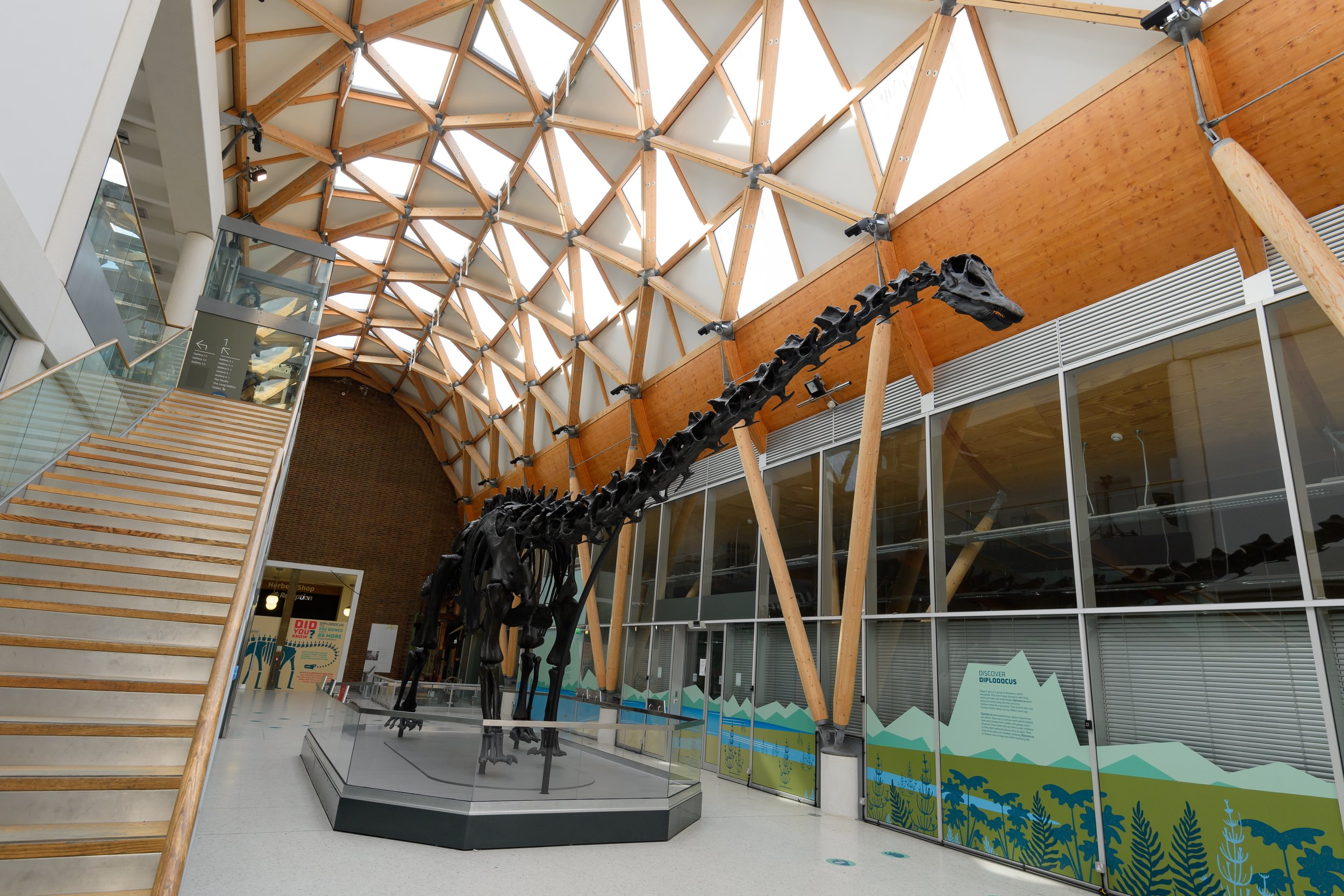
Dippy in Coventry
Dippy the diplodocus is on loan from the Natural History Museum, London
Fresh from its recent return home to the Natural History Museum, Dippy the Diplodocus (DIP-low-DOCK-us) has stomped into Coventry and set to remain as dino-in-residence at the Herbert Art Gallery & Museum until 2025!
Dippy the dinosaur is a life-size, plaster-of-paris replica of a Diplodocus carnegii skeleton. It was gifted to the Natural History Museum by Andrew Carnegie and was first put on display in May 1905. Dippy quickly became a star, capturing hearts and imaginations, and went on to tour the UK from 2017 to 2021. After a brief return home to London, Dippy arrived in Coventry this year, and has been delighting visitors since February 2023.
Dippy is loaned to Herbert Art Gallery & Museum from the Natural History Museum collection for an initial three-year period.
To find out more or book your free tickets please visit www.DippyinCoventry.co.uk.
10 Facts You Probably Didn’t Know About Dippy
1. Dippy is a replica Diplodocus skeleton but you’ve been saying it wrong all this time - or have you? There are a number of pronunciations you tend to hear. Firstly, the more bouncy dip-low-DOE-cus and secondly the more rushed dip-LOD-oh-cus. A third possible pronunciation is DIP-low DOCK-us. Well apparently, based on the etymological history of the word, all these pronunciations are correct and make sense. However, it does give you an idea why ‘Dippy’ was picked for short.
2. The first recorded Diplodocus fossils were discovered in 1877 in a quarry in Colorado.
3. Humans are closer in time to Tyrannosaurus rex, than T-Rex was to the Diplodocus.
4. There haven’t been enough Diplodocus specimens found to know if Dippy is male or female. That is why today Dippy is known as ‘they’.
5. Diplodocus had 292 bones. That’s 86 more than humans! And it’s even more if you count all the bones in their head – 356.
6. At one point it was believed a Diplodocus could whip its tail faster than the speed of sound. However this is unlikely and according to a recent study which suggests it could move at over 70 miles an hour.
7. All dinosaurs laid eggs. To date, no nesting sites have been found for Diplodocus so we don’t know what their nests or eggs were like.
8. Dippy is a composite skeleton. One specimen makes up most of the skeleton, but several others were used to fill in the missing pieces, including the skull.
9. It takes two people two days to dust Dippy. This is done roughly every two years.
10. Diplodocus were herbivorous, which means they ate plants. They had 42 narrow teeth which helped them strip leaves from conifer and ginkgo trees. However, these teeth did not have to last a lifetime as they were replaced about every 35 days.
Exhibition Flythrough
Also On Display
3D Replica Dippy Skull
Dippy had more than 40 pencil-shaped teeth. These allowed Dippy to strip leaves from gingko and conifer trees.
Eating leaves were hard on Diplodocus teeth and they were replaced about every 35 days.
Ammonite
This ammonite was found in Bishop’s Itchington, Warwickshire. Despite being large compared to others in the display, it is still only a quarter of the size of the largest ammonite found to date.
Fish
The dark spots in this rock are the teeth of a fish called Eomesodon. They are known as palatal teeth as they form part of the fish’s mouth rather than growing as separate teeth within a jaw.
Fossils
(kindly loaned by Warwickshire Museum and Heritage & Culture Warwickshire)
Plesiosaur vertebra 1/2
Dapedium
This fish is a species called Dapedium. It had thick scales and bony fins, known as ray-fins.
Plesiosaur vertebra 2/2
Ichthyosaur vertebrae and ribs
ichthyosaur vertebrae and ribs in a rock matrix from Harbury, Warwickshire.
Plesiosaur flipper bone
Plesiosaur flipper bone from Bishop’s Itchington Quarry.
Plesiosaur spine
Ichthyosaur skull
This specimen, along with tens of others, was found at Harbury Cement Quarry, Warwickshire in 1933. A well-known Coventry naturalist and member of the Coventry and District Natural History and Scientific Society, EF Nicholls, arranged for the skull to be moved from the quarry to Coventry for display.
Paddle, or flipper, bones from a marine reptile
Jaw of a species of Ichthyosaur
This is the jaw of a small species of ichthyosaur, probably Ichthyosaurus communis. This type of ichthyosaur was about two metres long.












